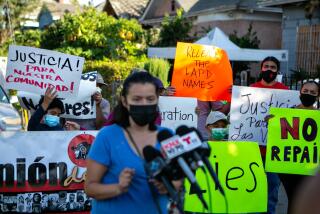Fired Mortars Without Watching Copter, ‘Twilight’ Aide Says
- Share via
Special-effects technician James Camomile acknowledged Tuesday that he did not look up as he should have from his firing board before triggering the explosives that accidentally knocked a helicopter out of the sky, striking and killing three actors on the “Twilight Zone” film set.
Camomile also admitted to jurors that it was his responsibility to make sure that conditions were safe before he ignited the mortars. But the witness added that he did not act negligently because, after taking an initial glance, he believed that the helicopter was a safe distance away before touching off the first of eight mortars on the board.
The volatile testimony by Camomile, who has been granted immunity by the prosecution, came on his second day on the witness stand in the Los Angeles Superior Court involuntary manslaughter trial of film director John Landis, special-effects coordinator Paul Stewart and three associates who also worked on the movie.
Actor Vic Morrow and two child actors were killed in the 1982 accident when a low-flying helicopter spun out of control in the filming of a Vietnam battle sequence after being struck by the fireballs from the fourth and fifth special-effects mortars that Camomile fired.
Close Proximity
Deputy Dist. Atty. Lea Purwin D’Agostino contends that the defendants acted with criminal negligence by placing the actors in close proximity to explosives and a helicopter. The defense counters that the accident was not criminal in nature, having been caused inadvertently by Camomile’s failure to wait until the aircraft was a safe distance from the mock Vietnam village before he fired.
In a lengthy day of cross-examination, Camomile made several contradictory and confusing statements concerning the placement of the mortars and other aspects of the case, some appearing to help the defense and some appearing to help the prosecution. Nonetheless, the key prosecution witness repeatedly agreed with defense claims concerning his own role in the fatal sequence.
Most dramatic was a series of questions posed by Landis’ attorney, James F. Neal.
Scene Unfolds
“Isn’t it a fact that it is the responsibility of the man on the firing board not only to know . . . where the special effects are but also to watch the scene as it unfolds to see where the actors are and where the helicopter is?” asked Neal, a one-time Watergate special prosecutor, in his rolling Nashville drawl.
“That’s correct sir,” Camomile, a 10-year veteran technician, quickly replied.
“Even though you know when you’re on the firing board where the helicopter is supposed to be--whether you have a diagram or not--the man on the firing board has to watch where the helicopter actually is before setting off the special effects,” continued Neal.
“Yes sir,” Camomile said.
“And isn’t it a fact,” added Neal, pausing for emphasis, “that the person on the firing board has the last say as to whether it is safe to fire or not?”
“That’s correct,” Camomile replied.
Similar Answers
Camomile, who gave similar answers to queries by Stewart’s attorney, Arnold L. Klein, appeared to bristle, however, when asked by another defense attorney whether his actions had fallen below the proper standards of care for special-effects technicians.
“I acted on the best interests of all parties involved,” Camomile told Harland Braun, counsel for associate producer George Folsey Jr. “ . . . (I thought) the helicopter was safe distance.”
Outside court, defense attorneys told reporters that Camomile’s testimony substantially bolstered their case.
“I’d say this fellow made a mistake. He was told what to do and he made a mistake. It was as simple as that,” Neal said. “Nobody should be prosecuted criminally for this case. Not every mistake in life is a criminal offense notwithstanding what Mrs. D’Agostino says.”
Places Blame
D’Agostino countered that the five defendants bear criminal responsibility because “the scene was dangerous on its face because of the proximity of the helicopter, explosions and human beings to one another.”
She said Camomile had not been adequately instructed about the distance the helicopter would be from the explosives, but had a right to rely on information he had received from his superiors.
More to Read
Only good movies
Get the Indie Focus newsletter, Mark Olsen's weekly guide to the world of cinema.
You may occasionally receive promotional content from the Los Angeles Times.










